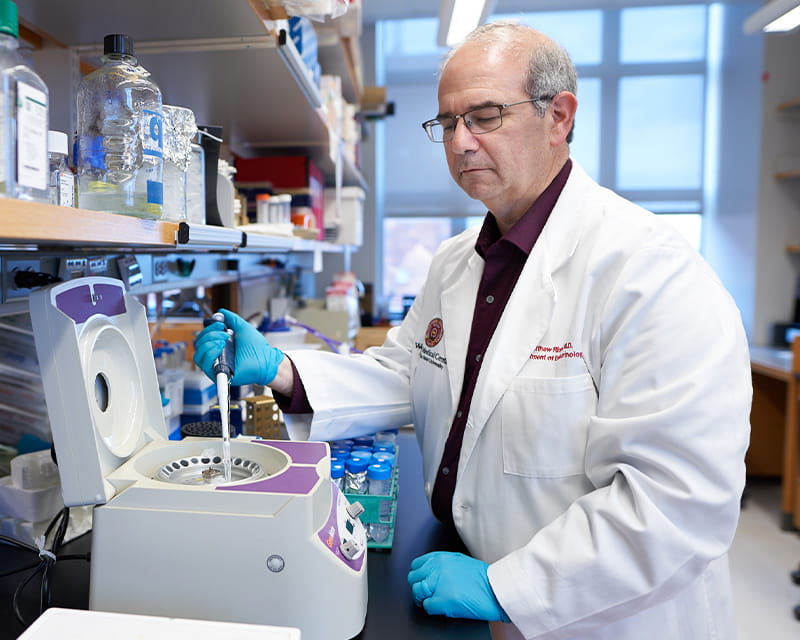
Studying “brake failure” in thyroid cancer metastasis
 Physician-scientists at The Ohio State University Wexner Medical Center are making strides in understanding why obesity increases the risk of diabetes and other medical conditions, including nonalcoholic steatohepatitis (NASH).
Physician-scientists at The Ohio State University Wexner Medical Center are making strides in understanding why obesity increases the risk of diabetes and other medical conditions, including nonalcoholic steatohepatitis (NASH).
Their insights and efforts may pave the way for new treatments that decrease blood sugar or liver fat to normal or less harmful levels — especially in conjunction with weight loss.
For the last several years, Ohio State endocrinologists, including David Bradley, MD, and Willa Hsueh, MD, a professor at the College of Medicine, have studied how immune cells within visceral and subcutaneous adipose tissue affect inflammation that leads to metabolic and cardiovascular disease.
After collecting adipose tissue from lean and obese patients, the team found that a protein called clusterin was over expressed in the fat cells of obese patients.
“We discovered that as clusterin expression from the fat cell, or adipocyte, increased, so did insulin resistance, blood pressure, dyslipidemia and key markers of heightened cardiovascular disease risk,” says Dr. Bradley, who is associate director of Clinical Trials in the Division of Endocrinology, Diabetes and Metabolism.
“Importantly, these clinical associations were independent of other traditional risk factors including age, gender and smoking status,” he adds. “We also looked at clusterin expression and secretion in knockout mice fed a Western diet, and we found that increased clusterin was closely associated with a progressive increase in atherosclerosis and liver fat.”
Their results, which were published in Diabetes Care in March 2019, highlight the potential for clusterin to be a novel factor linking human metabolic and cardiovascular disease.
In a related effort, Dr. Bradley and his colleagues were the first to discover that people with excess adipose tissue have fewer regulatory T cells (Tregs), which normally help suppress inflammation and regulate immune system activity. However, Dr. Bradley’s team found that Treg cell levels in adipose tissue correlated closely with insulin resistance.
“Our lean subjects had more Tregs and higher insulin sensitivity, while our obese subjects had fewer Tregs and higher insulin resistance,” Dr. Bradley, who is an assistant professor at the College of Medicine, explains. “Our next step is to determine why Tregs go down in obesity and metabolic diseases, and understand the mechanisms by which Tregs lead to a higher risk of metabolic disease.”
Obesity and insulin resistance are also risk factors for developing NASH, a type of nonalcoholic fatty liver disease that often leads to cirrhosis or liver cancer. It also increases the risk of death from cardiovascular disease.
Even though NASH is the third leading diagnosis requiring a liver transplant in the U.S., there are no Food and Drug Administration (FDA)-approved medications to treat it. But that may soon change, thanks to clinical trials taking place at Ohio State and other institutions. Dr. Bradley is the site principal investigator for the REGENERATE study, a phase III, multicenter trial to test the safety and efficacy of obeticholic acid versus a placebo for treatment of NASH.
“Currently, the only way to reduce NASH complications is weight loss through diet and exercise,” Dr. Bradley says. “However, obeticholic acid, which is currently under evaluation by the FDA, was shown to improve liver health in 45% of participants in the phase II FLINT study.”
Results of the pivotal FLINT study showed that NASH patients who took obeticholic acid had decreased fat, inflammation and fibrosis in the liver, along with decreased body weight. However, participants in the experimental group were also more likely to have side effects, including itching and an increase in total cholesterol, which prompted the need for a larger study to continue investigating the drug’s efficacy and safety.
Even though healthy dietary intake is key to diabetes management, it is often difficult to achieve. That’s why Ohio State clinicians and researchers have partnered with Local Matters, a Columbus nonprofit organization that aims to create healthy communities through food education, access and advocacy.
Together, they’re offering patients with diabetes a six-week, hands-on cooking program called Cooking Matters — and tracking certain outcomes to see whether dietary changes can make a measurable difference in health and well-being.
Led by Ohio State dietitian Jennifer Shrodes, RD, CDE, and a chef from Local Matters, the program strives to improve participants’ diabetes self-management skills, hemoglobin A1C and quality of life. It also provides diabetes-specific medical nutrition therapy.
Researchers will assess participants’ hemoglobin A1C levels and self-reported quality of life scores prior to and after the class.
This initiative is funded by the Diabetes Care and Education Dietetic Practice Group’s Karen Goldstein Memorial Grant for Diabetes Medical Nutrition Therapy.